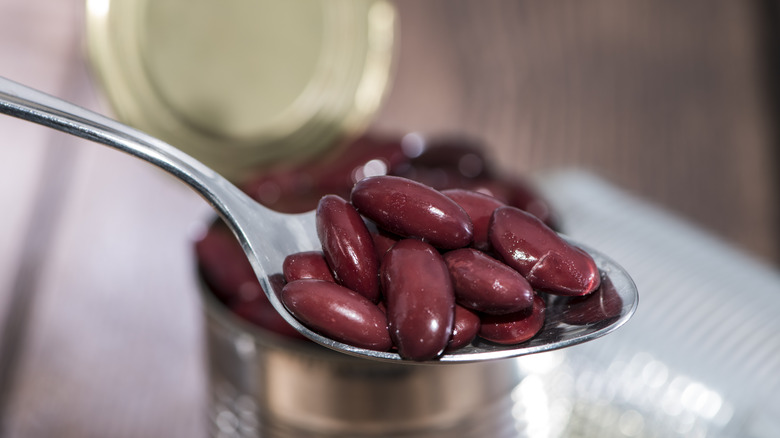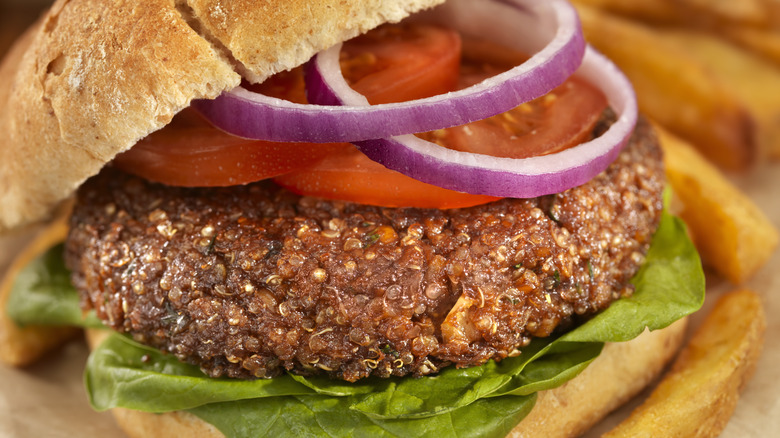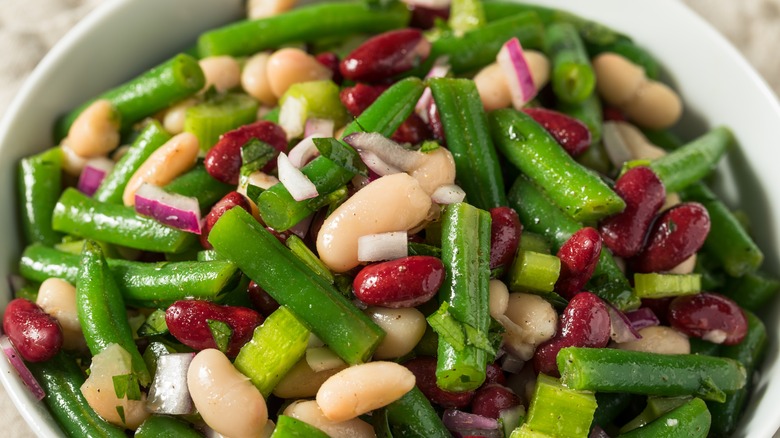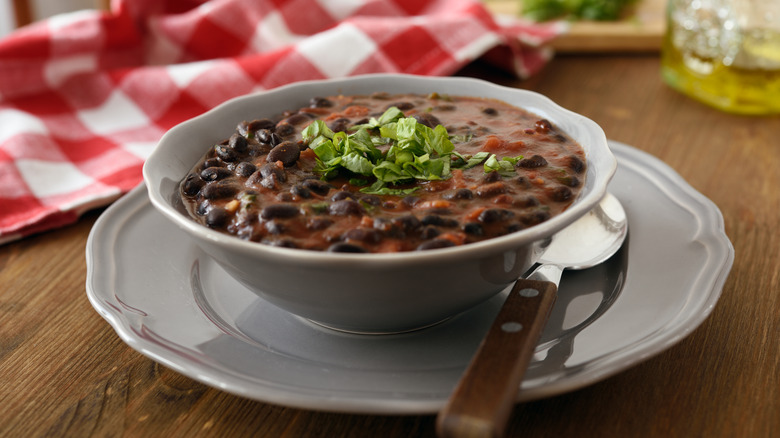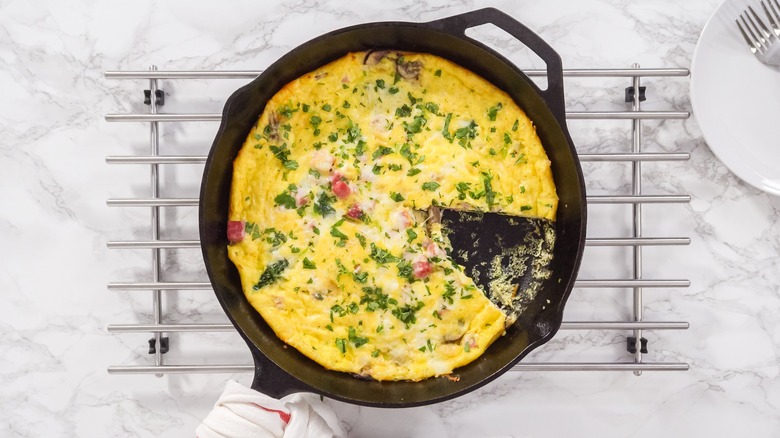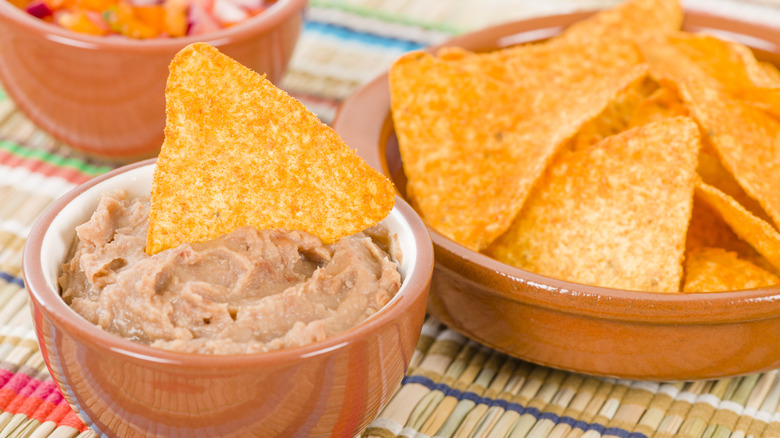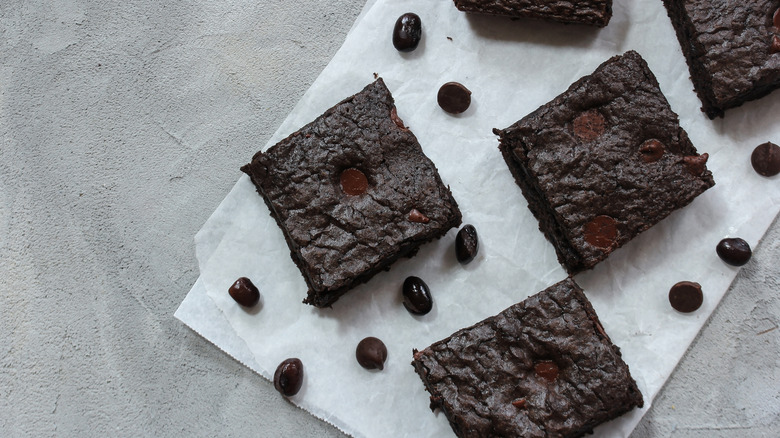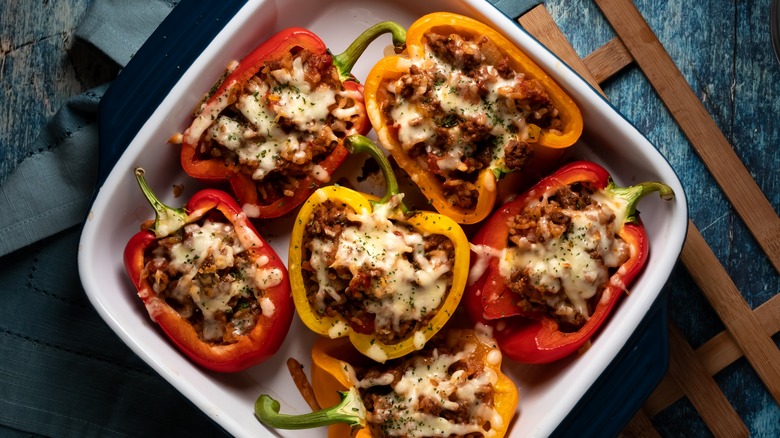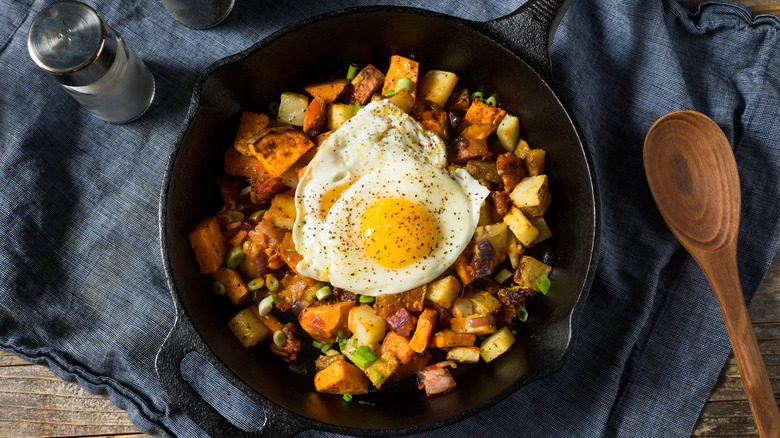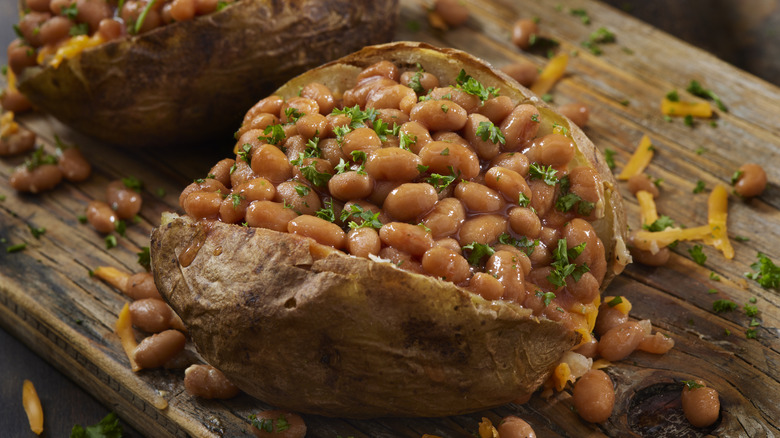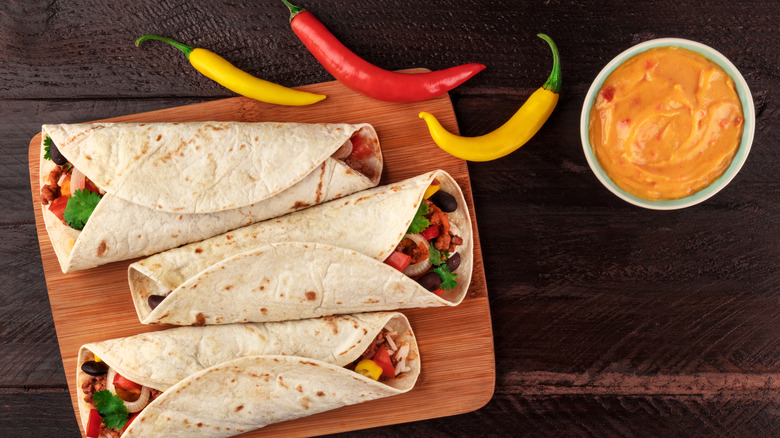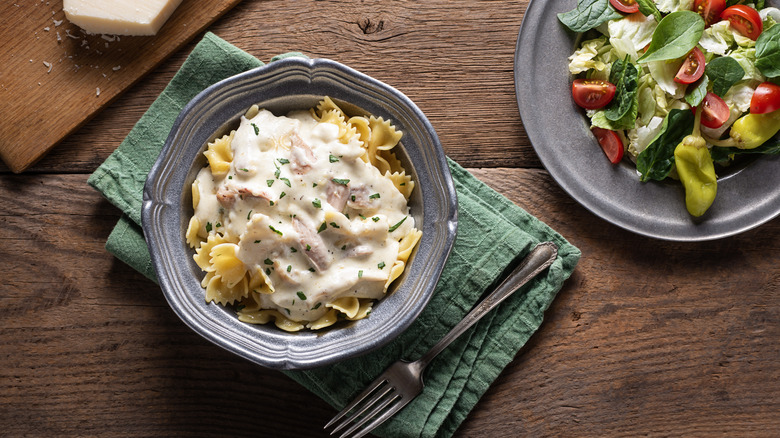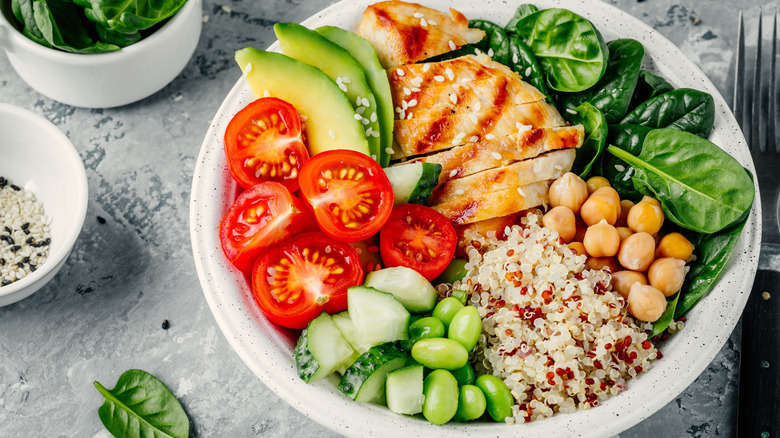13 Delicious Ways To Use Canned Beans And Lentils
If you're not using canned beans or lentils to hack your time in the kitchen, you're making a huge mistake. These canned goods can be beneficial in numerous ways. For one, they're already cooked, so you don't have to deal with the hassle of soaking and cooking dried beans. They're also relatively affordable and have a long shelf life, so you can stock up on them without worrying about them going bad quickly. Every bean and lentil is different, but generally, all contain impressive amounts of protein and fiber, adding to their list of pleasant qualities.
You can use these versatile ingredients to make delicious dishes, including breakfasts, sides, and party appetizers — next time you're unsure what to make for dinner, you can refer back to these ideas. We'll also provide information on which beans work best for each method based on their texture, flavor, and other characteristics, so you don't have to take any guesses. Grab your can opener because you'll definitely want to make one of these flavorful creations.
1. Make veggie burgers
You've probably heard of a black bean burger, but those aren't the only beans you can use in plant-based patties. If you want a creamy, tender bean, opt for pinto beans. Chickpeas work when you want something creamy but with a firmer consistency. On the flip side, kidney beans are best if you want something meatier because they have a nice chew.
Veggie patties are customizable. They usually have a protein (in this case, beans), assorted veggies, grains or other binders, and spices. Sometimes, they include other ingredients like fresh herbs, nuts, or seeds. It's important to include a binder when making your patties so they don't crumble. Sometimes, all it takes is an egg or two. For vegans, other options, like oats, breadcrumbs, or rice can work in place of the eggs.
Whichever kind of beans you use, drain and rinse them to remove all liquid. Slightly mash them to break them up so they can blend with the other ingredients more easily. You can leave some whole, though, for texture purposes. Then, cook your preferred vegetables and chop them into small pieces, combining them with the beans, binder, and other components. If the texture is right, you should be able to scoop the mixture and squeeze it in your hand without it instantly falling apart. Add some water if needed. To complete the job, cook both sides of the patties in a grill pan with some oil until browned and thoroughly heated.
2. Craft a bean salad
One of the absolute best ways to take advantage of canned beans is to create a salad with them. You might've heard of three-bean salad, which typically comprises green beans, garbanzo beans, and kidney beans, but you can swap them for other types, whether for personal preference or to use what you have on hand. As substitutions, black beans, cannellini beans, or wax beans also work well. And who's to say you have to limit yourself to precisely three kinds? You can always use more or less.
Aside from the main ingredients, this dish also benefits from a rich yet tangy dressing that accentuates the taste of the legumes. Many recipes use olive oil, sugar, and some type of vinegar for acidity. You can start with a basic recipe and add any seasonings and fresh herbs that you like.
These aren't the only components you should use, either. You need something crunchy for a really good bean salad. For example, you can add fresh onions, radishes, bell peppers, or celery. This can also give some flair to the dish. Lastly, after you toss everything together, let it marinate in the refrigerator for a few hours before serving, which creates a deeper flavor and ensures everything is thoroughly chilled.
3. Make bean soup
For a comforting supper, transform your canned beans or lentils into some hearty soup. You can make white or black bean soup, where you purée a portion of the mixture for a creamy texture. To make it, sauté vegetables and seasonings in a large pot before adding stock and beans. Gently simmer the mixture until the vegetables are tender, and the beans are softer. You can purée the entire mixture, but the texture is better if you leave it a little chunky. An easy way to do so is to use an immersion blender or only run a portion of the soup through a blender.
Lentil soup is also a great option, as it has its distinct, earthy flavor. You can use any type of lentil and stock, seasonings, and vegetables. Use a similar approach to the bean soup, partially puréeing it to create a pleasing consistency. Although these soups are delicious when plant-based, they don't have to be meat-free. There's no harm in adding something like sausage, diced ham, or pulled chicken if that is what you favor. In any case, the legumes add substance and protein to the recipe.
4. Add them to a frittata
Next time you make a frittata, consider opening a can of beans from your pantry. Legumes can add a unique flavor to frittatas, and it's especially delicious if you pair them with complementary vegetables or meats. Furthermore, the texture of certain ones, like black beans, counterbalances the softness and creaminess of the egg dish.
One way to experiment with this concept is to make a southwest-style frittata. Add corn, bell peppers, onions, and cheese with the black beans. For best results, use a cast iron skillet. Sauté the veggies, then add the legumes. Once the vegetables soften and the beans are hot, use your spatula to evenly spread them in the pan. Then, pour the egg mixture to coat them entirely, sprinkling on some shredded cheddar cheese afterward. You can move the frittata to the oven to finish cooking once the edges firm up.
Another delicious option is to make a frittata with white beans. In this version, add ingredients such as spinach, chopped artichokes, and garlic. You can use the same method, cooking the mix-ins before you dump the eggy mixture on top. Use fresh spinach rather than frozen to prevent it from being watery. This frittata type also benefits from a nuttier cheese, such as Gruyère.
5. Make party dips
There are many possibilities when it comes to creating dips from canned legumes, so if you're looking for a crowd-pleasing appetizer, this can be a great option. For instance, you can make an easy and cheesy refried bean dip. All you have to do is use canned refried beans and mix them with sour cream or cream cheese, taco seasonings, and shredded cheese. Transfer the mixture to a casserole dish, sprinkle on more cheese, and pop it in the oven until it's thoroughly heated and the cheese melts. Serve it with freshly made tortilla chips.
Another idea is to make a white bean dip, although this takes more effort since the beans start out whole. Nevertheless, the effort is worth it, because it offers an entirely different flavor profile. Often, white bean dips contain bold ingredients like lemon zest and juice, garlic, and fresh herbs. You can add those ingredients, olive oil, and white beans into a food processor. The oil is essential for richness and moisture, but you might also need to add water if it is too thick to mix properly. Once ready, you can dip crackers, pita bread, or crisp veggies into it.
Of course, these aren't the only dips you can make with beans. Let's not forget about classics like seven-layer bean dip or hummus. No matter which type of legume you have, there's a good chance you can find a recipe to make a dip out of it.
6. Bake with them
When you open a can of beans, you might not immediately consider using them in desserts if you associate them with savory foods. However, certain kinds can benefit your baking projects. First, beans can replace the flour or fat in basic recipes, which can be advantageous for people with special diets. It's also handy if you run out of a particular ingredient while making something. Second, they add protein and fiber to the recipe, boosting the nutritional value of the treat.
Believe it or not, when used in suitable recipes, you won't even notice the beans' flavor. Chocolate, peanut butter, bananas, and other strongly flavored ingredients easily overpower their taste. You can use white beans for recipes with light doughs, like blueberry muffins or oatmeal cookies. That way, you don't run into the issue of your dessert becoming an entirely different color. Similarly, you can use black beans for chocolate-based desserts.
To use the legumes in baking, don't leave them whole, but create a purée with them first by running them through a blender or a food processor. They can replace half the amount of fat in a recipe. For gluten-free or flourless recipes, the beans can add much-needed structure. However, when using them this way, find a tested recipe since other factors, such as the type of chocolate used, might determine how effectively the beans work in the finished dish.
7. Use them as a stuffing
Both lentils and beans are excellent filling ingredients for stuffed bell peppers or chicken. This concept is highly adaptable since you can pair them with various other ingredients. For instance, make stuffed bell peppers by hollowing out large peppers and roasting them. Meanwhile, make the filling on the stovetop. Sauté veggies and meat of your choice with olive oil. Once done, add cooked rice and drained canned beans or lentils. Stir the mixture on the stovetop until everything is evenly heated. Season to taste before you fill the roasted peppers with the stuffing. Sprinkle on shredded cheese and place them in the oven to melt the top.
On the other hand, the process with the stuffed chicken looks different. You need to fill the meat while it's raw. Using a sharp knife, slice the meat lengthwise without going all the way through. If you cut it in half, the ingredients fall out, and the top piece slides off. So, instead, create a pocket for the stuffing to fit into. Make the filling using ingredients similar to those of the peppers. Generally, you can include shredded cheese, assorted veggies, and your choice of legumes. But you can also get creative and add other components such as pesto, cream cheese, or even other types of meat (bacon or ham are good options). Fill the pockets and secure it together with a toothpick if needed. Bake them until their center hits an internal temperature of 165 degrees Fahrenheit.
8. Make a breakfast hash
If you don't use legumes in your breakfasts, now is the time to start. Specifically, beans can be a great addition to a breakfast hash. In a hash, you might find tender vegetables, meaty sausage crumbles, fluffy potatoes, or the creamy yolk of a fried egg. However, the dish will benefit from the unique texture of beans. Not to mention, using beans can also boost the nutritional content of the breakfast, especially the protein and fiber.
When choosing which ingredients to use in your meal, think about which meats and beans you like together. In terms of veggies, you can never go wrong with peppers, onions, and root vegetables. Presentation is also important. For instance, if you want your meal to be eye-catching, using sweet potatoes with your beans can make for a colorful breakfast hash. If you use black beans, can give some color contrast too. Alternatively, kidney, pinto, garbanzo, and great northern beans are all fantastic options. Add these during the last few minutes of cooking, as canned beans don't need much time on the heat.
9. Top a baked potato
Not quite sure what to top your baked potato with? There's nothing wrong with classic bacon bits, sour cream, and chives, but sometimes you might want something with more substance. This is where canned beans and lentils come in. It's simple since you can just rinse, drain, and heat them. In terms of types, lentils, pintos, or black beans are good options and pair with many other toppings. However, if you want to take it up a notch, use baked beans or ranch-style beans, which are pre-seasoned. These options can impart extra savory and smoky flavors to the meal.
When making your baked potato, you can opt for an entirely plant-based dinner by combining the beans with cilantro, avocado pieces, green onions, and diced tomatoes before pouring them onto the potato. Meanwhile, if you want to use meat, try ground turkey, chorizo, or pulled chicken. Season and cook the meat before you mix it with your preferred legume.
10. Make a hearty chili
The topic of including beans in chili can be controversial to some. Why, you ask? Well, traditional red chili recipes typically don't include beans but are made with meat, seasonings, and chili peppers. However, over time, adding beans, vegetables, and grains has become more common. If you're open to the idea, adding beans to your chili can be a great way to use them.
The best type of bean to use in chili is, by far, kidney beans. They have a pleasant, sweet undertone that helps create balance with the many spices. They also have a dense structure, so they don't instantly turn to mush when you cook them. You can also use black beans for this same reason. Lastly, pinto beans are creamy yet earthy, so they taste delicious in chili, but their texture isn't as ideal since they soften quickly. You can add them just before serving to prevent any issues. Ultimately, you can choose one type or create a three-bean chili if you just can't decide.
11. Include them in your favorite Mexican dish
Canned beans can be a terrific addition to many Mexican dishes. Many people prefer to use dried beans, but the canned kind is a convenient alternative if you're short on time. Of course, adding them later in the cooking process is important to keep them intact. This is especially true with recipes like Mexican stews, where the liquid slowly simmers over a long period.
Another way to use them is in fillings or toppings. For example, include some black or pinto beans in enchiladas, tacos, or burritos. They pair with virtually any kind of meat, rice, vegetable, and cheese combo you can think of. You can also use them as a nacho topping. If you plan to make oven nachos, add the beans underneath the cheese to prevent them from drying and cracking. You can also heat them on the stovetop separately and add them to the nachos as a finishing touch.
12. Make homemade pasta sauce
You can add certain canned legumes to pasta sauce for flavor and thickening. With lentils, the red or brown kinds are ideal, but you can certainly use green if you don't mind their bolder taste. Lentils can stretch out your pasta sauce while adding a nice, earthy undertone. You can add them whole, to appreciate their texture, or purée them before you include them in the sauce. Remember though, that puréed lentils will thicken the sauce significantly, so you may need to add more liquid to compensate. This can be good if you're trying to stretch the sauce out, anyway.
If you're using beans, white varieties like cannellini or great northern beans are a safe choice because of their mild flavor — but compared to lentils, they are much chunkier and don't visually blend into the sauce as well, so running them through a food processor is best. You can also make a sauce with white beans as the main component, which will be super creamy. All you need to do is blend them with vegetable or chicken stock, seasonings, and garlic. Adjust the amount of stock until you reach the desired consistency, then heat the mixture on the stovetop.
13. Use them in a grain bowl
Use canned beans and lentils when you assemble a bowl filled with whole and nutrient-dense ingredients. Whether you call them nourish bowls, Buddha bowls, or grain bowls, these types of meals all have a similar concept. Typically, nourish bowls may contain meat, while the other varieties don't. Nevertheless, they all contain a primary protein accompanied by whole grains and veggies. You can use legumes as the primary protein or pair them with chicken, fish, beef, or even tofu if you want a more protein-rich meal.
Some ideas for grains are brown rice, quinoa, or barley. As far as vegetables go, you can use fresh, crisp veggies paired with creamy avocado. Rather than cooking all of the ingredients together, prepare them separately. You'll also want to drain the excess liquid from the canned beans or lentils before you use them. Layer the components into the bowl so you can see each part of the meal, giving it a stylish presentation. You can add sauces and finishing garnishes, too. Whether you want to serve it cold, like a salad, or serve it warm is up to you.
